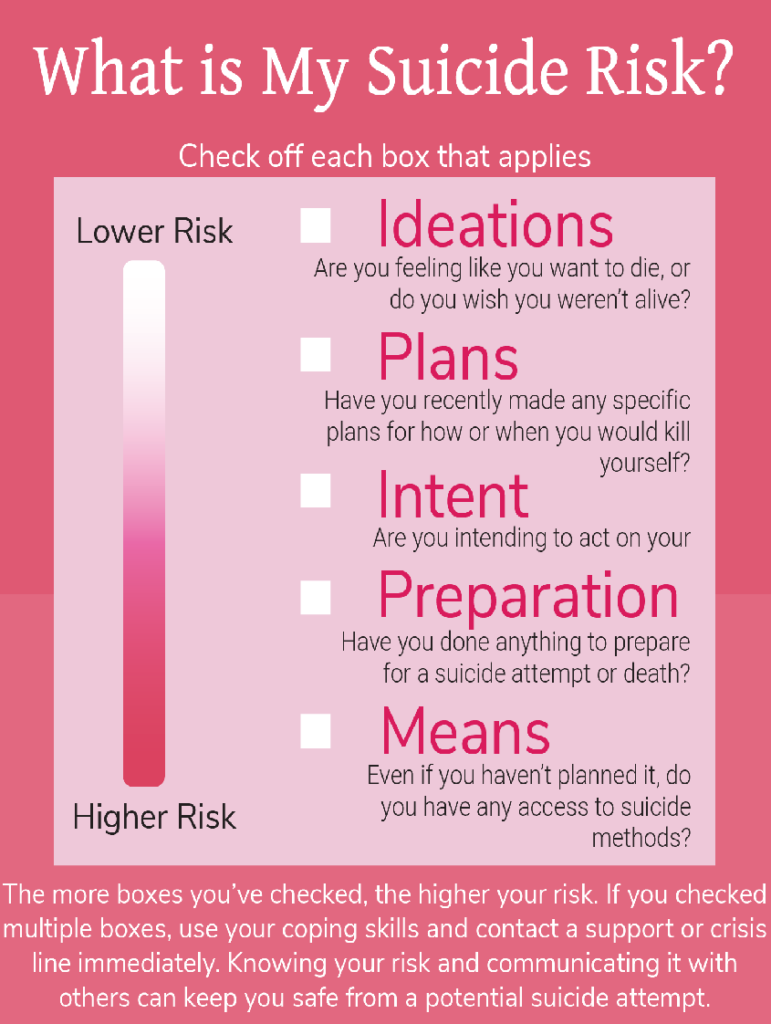By Adrienne Pastula
Trigger Warning: Suicide, Vague mention of Methods.
Let’s talk about suicide.
With the estimated suicide rate flying high for those of us with PMDD, it’s necessary to speak candidly about the risks so we can avoid being a part of that statistic. But talking about suicide is often frightening or difficult. Not only that, but there is also an unhelpful taboo around talking about suicide, perhaps even more significant than the taboo for talking about menstruation. This creates a dangerous environment for those of us who experience ideations. Studies have shown that mentioning or discussing suicide, even with people who are feeling suicidal,

Ideations
Ideations can be passive or active, with active being higher risk. Passive ideation might include thoughts of wanting to die, fantasies about death or methods for committing suicide, or even just thoughts of escape. Thoughts of wanting to run your car off the road while you’re driving, or wishing you could be the victim of a fatal accident are other examples of passive thoughts. Recently wanting to kill yourself, or having recent thoughts that flooded into the next few categories, would constitute active ideations. Having ideations, while agonizing, are almost always ok for me and something I know I can cope with on my own, especially when I’m feeling less impulsive and don’t have access to any means of following through with a suicide attempt.
Plans
Plans are the next step up in risk for suicide, and they involve more targeted ideations. If you’ve progressed from thinking generally about wanting to die to planning out how and when you might do it, this puts you at higher risk for a suicide attempt. Whenever I’ve noticed my thoughts directing me toward plans, I have an increased interest in Google searching methods for suicide, almost as if I’m window shopping for the best one. Opening up Google is my reminder to use my coping skills and call a friend, so I don’t allow my mind to obsess over any real plan. And because I’ve never researched methods, I’ve prevented my fantasies from becoming too realistic.
Intent
Distinguishing between intent and planning can be tricky, especially if you’re in the throes of an episode. But intent requires a level of seriousness or resolve to follow through with your suicide plan. While the planning stage has an almost wistfulness to it “I could kill myself doing x,” intent sounds more like “I will kill myself doing x.” If your thoughts ever bring you here, you absolutely should contact someone for help, especially if you have the means to act on your plan. Never underestimate the role of impulsivity in managing suicidal ideations.
Preparation
Some suicide attempts are entirely impulsive, while others do require some planning. Preparation might include behaviors that increase your access to the means of committing suicide, like stockpiling medications. However, writing a suicide note or even just making an effort to get your affairs in order can also fall under preparation. If you are engaging in some out-of-character behaviors that are related to your desire to commit suicide, it is imperative that you contact a healthcare professional about your symptoms. If you’ve reached the preparation phase, you’re likely more disinclined to reach out for help, but always make an effort to protect yourself by letting someone know you’re in this place.
Means
This is the highest risk category because if you don’t have the means to commit suicide, regardless of where you are in terms of ideation, planning, intent, or preparation, it’s unlikely that you will be able to follow through with an attempt. However, even if you are only in the planning stage, but have the means, just a few minutes of heightened impulsivity can sometimes lead to an irreversible suicide attempt. To reduce the likelihood for accessing means, put dangerous items out of reach or in a safe where you don’t know the combination. With PMDD, it is especially important that you reduce your access to means during the days and weeks you expect to have symptoms. Talk to your therapist or supports about your planning fantasies so they can assist you if you’re in crisis. Access to means will be different for most people. I, for example, only have one serious plan that I gravitate toward when I’m suicidal, and I don’t have access to the things I need to carry it out. Others might have multiple options they need to protect against. No matter what, if you have the means for a successful suicide attempt, you need to discuss them with your supports, so they have the information to step in if needed.
Understanding where my suicide risk is for the day helps me communicate with my supports, and it can help me feel safer as well. I know that I can weather even the most intense suicidal ideations and plans so long as I don’t have any real intention to follow through with them. The few times I’ve dipped my toes into real conviction, that’s been my cue to call my sister or boyfriend to
*If you need support right now, reach out to a PMDD peer supporter, call the National Suicide Prevention Lifeline at 1-800-273-8255, or reach the Crisis Text Line by texting “START” to 741741.
About the Warrior
Adrienne Pastula
Adrienne is a Peer Support Provider and Administrative Assistant with IAPMD. She is a freelance writer with a focus on Mental Health and Women’s Health Advocacy.
Blog | Caffeine as an Anti-depressant | I am not a victim of my mental illness



